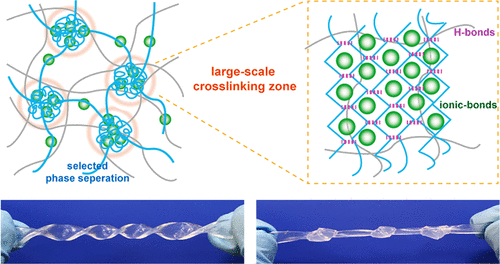当前位置:
X-MOL 学术
›
ACS Appl. Mater. Interfaces
›
论文详情
Our official English website, www.x-mol.net, welcomes your
feedback! (Note: you will need to create a separate account there.)
Selected Phase Separation Renders High Strength and Toughness to Polyacrylamide/Alginate Hydrogels with Large-Scale Cross-Linking Zones
ACS Applied Materials & Interfaces ( IF 8.3 ) Pub Date : 2021-05-20 , DOI: 10.1021/acsami.1c04577 Chongzhi Xu 1 , Xiansheng Zhang 2, 3 , Shuo Liu 2 , Xianwei Zhao 1 , Cunzhen Geng 1 , Lili Wang 1 , Yanzhi Xia 1
ACS Applied Materials & Interfaces ( IF 8.3 ) Pub Date : 2021-05-20 , DOI: 10.1021/acsami.1c04577 Chongzhi Xu 1 , Xiansheng Zhang 2, 3 , Shuo Liu 2 , Xianwei Zhao 1 , Cunzhen Geng 1 , Lili Wang 1 , Yanzhi Xia 1
Affiliation

|
High water content usually contradicts the mechanics for hydrogels, and achieving both characteristics is extremely challenging. Herein, a novel confined-chain-aggregation (CCA) strategy is developed to fabricate ultrastrong and tough hydrogels without sacrificing their inherent water capacity. Based on the popular polyacrylamide/alginate (PAAm/Alg) system with a double network (DN), a poor solvent exchange is induced once PAAm is fully cross-linked but prior to ionic cross-linking of alginate. In this case, the alginate chains are restricted by the chemical PAAm network and undergo a confined-chain aggregation, which guarantees an interpenetrating network of both polymers and simultaneously generates micron-scale aggregates. In addition, after the subsequent water uptake, the accompanying formation of hydrogen bonds and metal–ligand coordination stabilizes the newly formed alginate aggregates, serving as large-scale cross-linking zones. However, the PAAm chains are anchored by the preformed cross-linking points and convert back to the uniformly distributed, high-water-content state, achieving a selected phase separation in a DN system. The combined CCA and hybrid cation cross-linking method gives mechanical strength and toughness to the PAAm/Alg hydrogels to reach approximately 30 and 5 times the traditional methods, respectively. This investigation provides a general strategy for the development of a new generation of double-network hydrogels, which will expand their application as structural materials for cartilage and soft robotics.
中文翻译:

选定的相分离使具有大规模交联区的聚丙烯酰胺/藻酸盐水凝胶具有高强度和韧性
高含水量通常与水凝胶的力学相矛盾,实现这两个特性极具挑战性。在此,开发了一种新的受限链聚集 (CCA) 策略来制造超强和坚韧的水凝胶,而不会牺牲其固有的水容量。基于流行的具有双网络 (DN) 的聚丙烯酰胺/藻酸盐 (PAAm/Alg) 系统,一旦 PAAm 完全交联但在藻酸盐离子交联之前,就会引发不良的溶剂交换。在这种情况下,海藻酸盐链受到化学 PAAm 网络的限制并进行受限链聚集,这保证了两种聚合物的互穿网络并同时生成微米级聚集体。此外,在随后的吸水后,伴随形成的氢键和金属-配体配位稳定了新形成的海藻酸盐聚集体,作为大规模的交联区。然而,PAAm 链被预先形成的交联点锚定并转换回均匀分布的高含水量状态,从而在 DN 系统中实现了选定的相分离。CCA 和混合阳离子交联方法相结合,使 PAAm/Alg 水凝胶的机械强度和韧性分别达到传统方法的 30 倍和 5 倍。这项研究为开发新一代双网络水凝胶提供了一般策略,这将扩大其作为软骨和软机器人结构材料的应用。作为大规模交联区。然而,PAAm 链被预先形成的交联点锚定并转换回均匀分布的高含水量状态,从而在 DN 系统中实现了选定的相分离。CCA 和混合阳离子交联方法相结合,使 PAAm/Alg 水凝胶的机械强度和韧性分别达到传统方法的 30 倍和 5 倍。这项研究为开发新一代双网络水凝胶提供了一般策略,这将扩大其作为软骨和软机器人结构材料的应用。作为大规模交联区。然而,PAAm 链被预先形成的交联点锚定并转换回均匀分布的高含水量状态,从而在 DN 系统中实现了选定的相分离。CCA 和混合阳离子交联方法相结合,使 PAAm/Alg 水凝胶的机械强度和韧性分别达到传统方法的 30 倍和 5 倍。这项研究为开发新一代双网络水凝胶提供了一般策略,这将扩大其作为软骨和软机器人结构材料的应用。在 DN 系统中实现选定的相分离。CCA 和混合阳离子交联方法相结合,使 PAAm/Alg 水凝胶的机械强度和韧性分别达到传统方法的 30 倍和 5 倍。这项研究为开发新一代双网络水凝胶提供了一般策略,这将扩大其作为软骨和软机器人结构材料的应用。在 DN 系统中实现选定的相分离。CCA 和混合阳离子交联方法相结合,使 PAAm/Alg 水凝胶的机械强度和韧性分别达到传统方法的 30 倍和 5 倍。这项研究为开发新一代双网络水凝胶提供了一般策略,这将扩大其作为软骨和软机器人结构材料的应用。
更新日期:2021-06-02
中文翻译:

选定的相分离使具有大规模交联区的聚丙烯酰胺/藻酸盐水凝胶具有高强度和韧性
高含水量通常与水凝胶的力学相矛盾,实现这两个特性极具挑战性。在此,开发了一种新的受限链聚集 (CCA) 策略来制造超强和坚韧的水凝胶,而不会牺牲其固有的水容量。基于流行的具有双网络 (DN) 的聚丙烯酰胺/藻酸盐 (PAAm/Alg) 系统,一旦 PAAm 完全交联但在藻酸盐离子交联之前,就会引发不良的溶剂交换。在这种情况下,海藻酸盐链受到化学 PAAm 网络的限制并进行受限链聚集,这保证了两种聚合物的互穿网络并同时生成微米级聚集体。此外,在随后的吸水后,伴随形成的氢键和金属-配体配位稳定了新形成的海藻酸盐聚集体,作为大规模的交联区。然而,PAAm 链被预先形成的交联点锚定并转换回均匀分布的高含水量状态,从而在 DN 系统中实现了选定的相分离。CCA 和混合阳离子交联方法相结合,使 PAAm/Alg 水凝胶的机械强度和韧性分别达到传统方法的 30 倍和 5 倍。这项研究为开发新一代双网络水凝胶提供了一般策略,这将扩大其作为软骨和软机器人结构材料的应用。作为大规模交联区。然而,PAAm 链被预先形成的交联点锚定并转换回均匀分布的高含水量状态,从而在 DN 系统中实现了选定的相分离。CCA 和混合阳离子交联方法相结合,使 PAAm/Alg 水凝胶的机械强度和韧性分别达到传统方法的 30 倍和 5 倍。这项研究为开发新一代双网络水凝胶提供了一般策略,这将扩大其作为软骨和软机器人结构材料的应用。作为大规模交联区。然而,PAAm 链被预先形成的交联点锚定并转换回均匀分布的高含水量状态,从而在 DN 系统中实现了选定的相分离。CCA 和混合阳离子交联方法相结合,使 PAAm/Alg 水凝胶的机械强度和韧性分别达到传统方法的 30 倍和 5 倍。这项研究为开发新一代双网络水凝胶提供了一般策略,这将扩大其作为软骨和软机器人结构材料的应用。在 DN 系统中实现选定的相分离。CCA 和混合阳离子交联方法相结合,使 PAAm/Alg 水凝胶的机械强度和韧性分别达到传统方法的 30 倍和 5 倍。这项研究为开发新一代双网络水凝胶提供了一般策略,这将扩大其作为软骨和软机器人结构材料的应用。在 DN 系统中实现选定的相分离。CCA 和混合阳离子交联方法相结合,使 PAAm/Alg 水凝胶的机械强度和韧性分别达到传统方法的 30 倍和 5 倍。这项研究为开发新一代双网络水凝胶提供了一般策略,这将扩大其作为软骨和软机器人结构材料的应用。















































 京公网安备 11010802027423号
京公网安备 11010802027423号